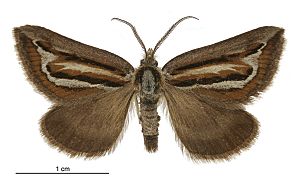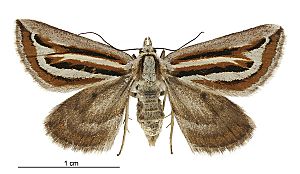Aponotoreas synclinalis facts for kids
Quick facts for kids Aponotoreas synclinalis |
|
|---|---|
 |
|
| Male specimen | |
 |
|
| Female specimen | |
| Scientific classification | |
| Synonyms | |
|
The Aponotoreas synclinalis is a type of moth also known as the Wirerush looper. It belongs to the Geometridae family. This special moth is found only in New Zealand, meaning it is endemic to that country.
Naming the Wirerush Looper
Scientists give names to all living things. This helps them study and understand different species. The Wirerush looper was first described by a scientist named George Vernon Hudson in 1903. He first called it Notoreas synclinalis.
This moth was discovered by Alfred Philpott. He found a special example of the moth near Invercargill on January 4, 1900. Later, in 1986, another scientist named R. C. Craw studied the moth again. He decided it belonged in a new group, or genus, called Aponotoreas. That's how it got its current scientific name, Aponotoreas synclinalis.
Where These Moths Live
The Wirerush looper moth is quite common in certain parts of New Zealand. You can often find it in the higher areas of the Catlins and the Longwood Range. It also lives on Stewart Island and in the southwest part of Fiordland.
What makes this moth interesting is where it can be found. Most moths of its kind live in higher places. But the Wirerush looper is one of only two species in its group that has been found living at sea level.
Moth Behaviour
The Wirerush looper is a "day-flying" moth. This means it is active during the daytime, unlike many moths that fly at night. You can usually see these moths flying around from January through March.
What the Caterpillars Eat
The young moths, called larvae or caterpillars, need specific plants to eat. The main food plant for the caterpillars of A. synclinalis is the Empodisma minus, also known as the lesser wire rush. In the high, mountainous areas of Stewart Island, the caterpillars also eat a plant called Dracophyllum politum.

